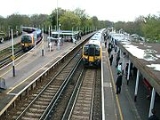
Virginia Water railway station
Encyclopedia
Virginia Water railway station serves the village of Virginia Water
, in Surrey
, England
. The station, and all trains serving it, are operated by South West Trains
.
The Waterloo to Reading Line
and the Chertsey Branch Line
join here with the platforms at the junction, as seen in the photograph (taken facing south). Trains from Weybridge and to Reading use either side of a V-shaped platform, allowing cross-platform interchange
; the junction of the tracks is at the London end of the station.
on 4 June 1856; the section to Weybridge opened on 1 October 1866. Formerly a chord south of the station connected the Chertsey and Reading lines.
The station received a new station building in 1973, similarly treated to Wokingham and Sunningdale, from prefabricated concrete
. The building is at the right of the photograph.
On Sundays, the two to Weybridge are replaced by one to .
Virginia Water
Virginia Water is an affluent village, a lake and, originally, a stream, the village being in the Runnymede Borough Council in Surrey and the bodies of water stretching over the borders of Runnymede, Old Windsor and Sunninghill and Ascot, England....
, in Surrey
Surrey
Surrey is a county in the South East of England and is one of the Home Counties. The county borders Greater London, Kent, East Sussex, West Sussex, Hampshire and Berkshire. The historic county town is Guildford. Surrey County Council sits at Kingston upon Thames, although this has been part of...
, England
England
England is a country that is part of the United Kingdom. It shares land borders with Scotland to the north and Wales to the west; the Irish Sea is to the north west, the Celtic Sea to the south west, with the North Sea to the east and the English Channel to the south separating it from continental...
. The station, and all trains serving it, are operated by South West Trains
South West Trains
South West Trains is a British train operating company providing, under franchise, passenger rail services, mostly out of Waterloo station, to the southwest of London in the suburbs and in the counties of Surrey, Hampshire, Dorset, Devon, Somerset, Berkshire, and Wiltshire and on the Isle of Wight...
.
The Waterloo to Reading Line
Waterloo to Reading Line
The Waterloo to Reading Line is a National Rail suburban electric railway line running generally westwards from London, England. It is operated by South West Trains...
and the Chertsey Branch Line
Chertsey Branch Line
The Chertsey Branch Line, opened in 1848, connects the Waterloo to Reading Line at to the South Western Main Line at . It is also referred to as the Weybridge Line.The line was electrified in the late 1930s by the Southern Railway....
join here with the platforms at the junction, as seen in the photograph (taken facing south). Trains from Weybridge and to Reading use either side of a V-shaped platform, allowing cross-platform interchange
Cross-platform interchange
A cross-platform interchange is a type of interchange between different lines in a metro system. The term originates with the London Underground; such layouts exist in other networks but are not commonly so named...
; the junction of the tracks is at the London end of the station.
History
The line from to including this station, was opened by the London and South Western RailwayLondon and South Western Railway
The London and South Western Railway was a railway company in England from 1838 to 1922. Its network extended from London to Plymouth via Salisbury and Exeter, with branches to Ilfracombe and Padstow and via Southampton to Bournemouth and Weymouth. It also had many routes connecting towns in...
on 4 June 1856; the section to Weybridge opened on 1 October 1866. Formerly a chord south of the station connected the Chertsey and Reading lines.
The station received a new station building in 1973, similarly treated to Wokingham and Sunningdale, from prefabricated concrete
CLASP (British Rail)
The CLASP system was a scheme developed in the 1950s by English local authorities to devise a method of designing and assembling prefabricated buildings for use in the public sector...
. The building is at the right of the photograph.
Platforms
Virginia Water station has four platforms.- Platform 1 - Fast trains to London Waterloo via Richmond.
- Platform 2 - Trains to Reading.
- Platform 3 - Stopping service to London Waterloo via Hounslow.
- Platform 4 - Trains to Weybridge.
Services
In trains per hour, Monday to Saturday, there are:- 4 to London Waterloo, of which:
- 2 are fast via RichmondRichmond station (London)Richmond station is a National Rail and London Underground station in the London Borough of Richmond upon Thames in south west London which is managed by South West Trains....
- 2 are stopping via
- 2 are fast via Richmond
- 2 to
- 2 to ,
On Sundays, the two to Weybridge are replaced by one to .

